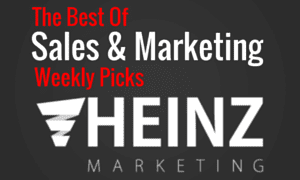Make Buyer Intent Work for Your B2B Strategy

Summary
This blog explains how B2B marketers can use buyer intent data to improve their outreach strategies. It covers how to find high-value prospects, segment the audience, and automate marketing processes. These tactics can help enhance lead quality and speed up sales cycles, leading to better results for the business.
By Karla Sanders, Engagement Manager at Heinz Marketing
In the crowded B2B marketplace, the difference between engaging a warm lead and wasting time on cold outreach often comes down to one key factor: buyer intent. While it’s well-known that intent data helps identify potential buyers, how do you actually use it to improve your marketing efforts? In this guide, we’ll explore how B2B marketers can leverage buyer intent data to enhance targeting, personalize outreach, and drive better results.
Speaking of intent data and tools, check out this essential guide to help you kickstart your journey towards becoming an AI-driven organization.
What is Buyer Intent Data?
Buyer intent data tracks the online activities of potential buyers—such as browsing behavior, content downloads, or engagement with specific keywords—that indicate interest in a particular solution or product. This data comes from multiple sources:
- Visits to your website
- Searches on third-party review platforms like G2 or TrustRadius
- Content engagement such as blog reads, webinar sign-ups, and whitepaper downloads
By analyzing these signals, marketers can identify prospects who are actively researching solutions and focus on those with the highest likelihood of converting.
Why is Buyer Intent Data Critical for B2B Marketers?
The value of buyer intent data lies in its ability to fine-tune your outreach. Rather than relying on generic campaigns, you can target buyers based on their actual behaviors, leading to:
- Improved targeting: Focus your efforts on prospects who are already signaling interest in your product or service.
- Better personalization: Tailor your messaging to the specific needs or pain points indicated by intent data.
- Shortened sales cycles: Engage with potential buyers earlier in their journey, when they’re actively researching and considering solutions
A 2023 Demand Gen Report found that 76% of B2B marketers using buyer intent data saw improved lead quality, while 68% reported faster sales cycles.
How to Leverage Buyer Intent Data for Your B2B Strategy
1. Start with the Right Tools
To effectively use buyer intent data, you need the right tools in place. Solutions like Bombora, 6sense, and ZoomInfo provide insights into buyer activity and surface critical intent signals. These platforms integrate with CRM systems and marketing automation tools to help streamline workflows between marketing and sales teams.
Actionable Tip: Invest in an intent data platform that aligns with your existing tech stack. Ensure that marketing and sales teams have access to the same data to avoid silos.
2. Identify and Prioritize Key Intent Signals
Not all buyer intent signals are equal. A prospect who visits your pricing page multiple times or downloads product guides is more valuable than someone who casually browses a blog post. Identify which intent signals indicate high buying intent versus those that signify early-stage interest.
Example: If a prospect repeatedly searches for “GRC solutions” on G2, visits your product page, and downloads a comparison whitepaper, they likely have a high level of buying intent and are further along in the decision-making process.
Actionable Tip: Prioritize prospects showing strong intent signals (e.g., multiple page visits, downloads, or webinar registrations) and tailor your outreach accordingly.
3. Segment Your Audience for Precise Targeting
Intent data allows you to segment your audience based on their behavior. Prospects who have interacted with your content in different ways can be placed into distinct categories such as:
- High intent: Actively researching and engaging with your product or solution.
- Medium intent: Engaging with relevant topics but not yet showing strong buying signals.
- Low intent: Early-stage interest, likely top-of-funnel.
Example: For high-intent leads, provide solution-oriented content like case studies or schedule a product demo. For medium- or low-intent leads, send educational materials like industry reports to nurture them along the funnel.
Insight: Regularly update your segments based on new intent data to keep your targeting relevant. As leads engage with new content or demonstrate different behaviors, adjust their segment accordingly.
4. Personalize Outreach Based on Intent Data
Buyer intent data enables marketers to craft highly personalized messages that speak directly to a prospect’s interests. The more relevant your outreach, the higher the likelihood of conversion. Here’s how:
- Tailored emails: Use intent data to inform email cadences with specific content related to the prospect’s interests.
- Personalized landing pages: Create dynamic landing pages that reflect the buyer’s industry, challenges, or needs based on their browsing behavior.
- ABM campaigns: Align buyer intent data with account-based marketing (ABM) to create hyper-targeted campaigns for key accounts.
Example: If a lead shows intent by attending your webinar on “Data Security in Cloud Solutions,” follow up with an email that offers a case study on your cloud security services and an invitation to schedule a personalized consultation.
Tip: Incorporate buyer intent data into your CRM to automate personalized messaging. For example, when a lead engages with specific content, use automated workflows to send follow-up emails tailored to that content.
5. Align Sales and Marketing Around Intent Data
The handoff between marketing and sales is critical. Buyer intent data can help ensure that sales is focused on the most promising leads. Set up a process where marketing can pass on high-intent leads to sales in real-time, and ensure sales teams know how to act on this data.
Actionable Tip: Hold regular alignment meetings between sales and marketing to discuss buyer intent insights and ensure both teams are on the same page about how to follow up with potential buyers.
Insight: Create a lead scoring system that incorporates intent data, allowing sales teams to prioritize follow-ups based on readiness to engage.
6. Automate Your Process
With the volume of data available, automation is key to making buyer intent data actionable. Use marketing automation tools to trigger personalized outreach when certain intent signals are detected (e.g., email workflows triggered when a lead downloads a whitepaper).
Actionable Tip: Set up automated email sequences based on specific intent behaviors. For example, if a lead visits your pricing page multiple times, trigger an email offering a product demo or a limited-time discount.
Insight: Regularly review and optimize your automation workflows to ensure they are effectively converting leads based on intent data.
Measuring Success: Key Metrics to Track
To ensure your intent-driven marketing strategy is working, track key performance indicators (KPIs) such as:
- Lead-to-MQL conversion rate: Measure how well your intent data is helping move leads through the funnel.
- Engagement rates: Monitor how personalized content is resonating with prospects.
- Time-to-close: Analyze how buyer intent data impacts the length of your sales cycle.
According to Gartner, B2B companies using intent data saw a 28% increase in pipeline opportunities and a 13% improvement in win rates compared to those that did not.
The Bottom Line
Buyer intent data is no longer a luxury—it’s a necessity for B2B marketers looking to drive meaningful results. By identifying key intent signals, segmenting audiences, and personalizing outreach, you can make smarter, data-driven decisions that shorten the sales cycle and improve conversions. With the right tools and strategies in place, buyer intent data can be a powerful force behind your B2B marketing success.
Make buyer intent work for your strategy, and watch your campaigns turn insights into action.
At Heinz Marketing, we’ve partnered with numerous B2B clients to develop customized business strategies tailored to their industry, market position, and unique challenges. If you’re looking to partner with an agency with a proven track record working on delivering a predictable pipeline while ensuring a consistent and effective customer journey approach, we’d love to help. Contact us for a complimentary 30-minute consultation at acceleration@heinzmarketing.com. Let’s explore how we can support your journey towards intelligent AI integration and drive your business forward.







